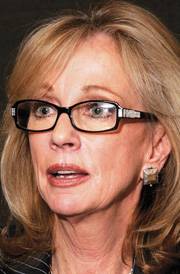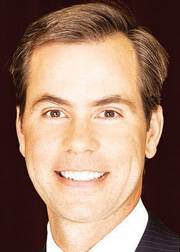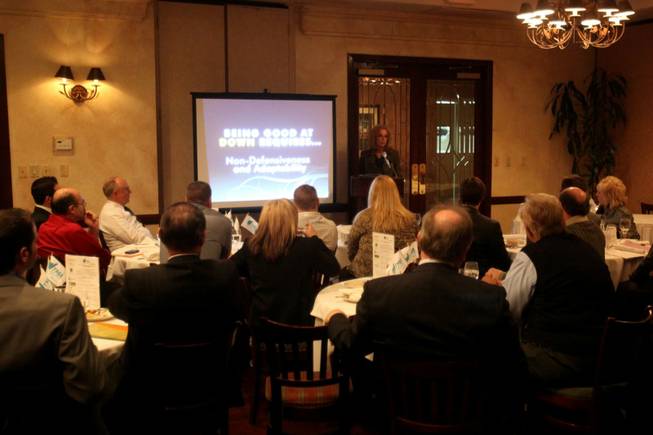Friday, March 5, 2010 | 2 a.m.

Jan Jones

Jonathan S. Halkyard
Sun coverage
Sun Archives
- Harrah’s debt gamble (2-15-10)
- Harrah’s gets OK for Planet Hollywood purchase; job cuts planned (2-3-10)
- Harrah’s buys Planet Hollywood debt (9-15-09)
- Harrah’s expects annual savings of $500 million (3-17-09)
- Harrah’s reports loss, says LV properties hit hard (3-13-09)
- Harrah’s announces plan to reduce debt burden (3-4-09)
- Strip building boom, buyouts were ill-timed, and many see more pain in ’09 (3-1-09)
- Harrah’s wants class-action suit over debt swap dismissed (2-27-09)
- Harrah's hit with class-action lawsuit over debt plan (2-16-09)
- Harrah’s seeking $740 million from credit line (2-13-09)
- Harrah’s makes cost-cutting moves (2-12-09)
Beyond the Sun
Gaming giant Harrah’s Entertainment’s ability to steer clear of bankruptcy while carrying massive debt through the Great Recession has many people wanting to know its secret.
But when two key executives gave the Turnaround Management Association of Las Vegas an inside look at what Harrah’s did to survive, some of the moves turned out to be surprisingly simple — time-honored formulas of hard-nosed cost-cutting and getting back to basics.
Jan Jones, Harrah’s senior vice president of communications and government relations, recalled how she tried to fight dramatic cuts to her budget in 2008 by arguing her case with CEO Gary Loveman.
“I took all my information to Gary and told him he was putting the business at a huge risk (by cutting her budget). He said to me, ‘If what it takes to save this business means that I have to close the entire corporate office, that is what I will do. These are your numbers. Make them work.’ And then he got up and he left.
“Looking back at it, I know now that it really took a leader who was saying, ‘Hey, get over it.’ ”
Jones, Las Vegas mayor from 1991 to 1999, said the entire gaming industry was flying high when she was in office, which provided a false sense of security for years.
“We couldn’t do anything wrong,” Jones said. “We were the fastest-growing city for 10 years, and we had the capacity to reinvent ourselves. Money was so available and credit limitations were not restricted.”
Harrah’s announced a private equity deal in December 2006, when the economy was thriving. Even though the deal with Apollo Management LP and Texas Pacific Group doubled Harrah’s debt, “we thought we were in a fairly good position for the new world,” Jones said.
Company officials were even more confident because “we were accustomed to thinking only one way because we were the best at what we did. Just ask any analyst. How could we be better than we already were?”
But before they could take the company private, the deal had to go before Harrah’s shareholders and gaming regulators for approval. It didn’t close until January 2008 — a month after the recession began.
“Here was our reality in 2008: We managed a highly leveraged business in a challenging economy; we had tight credit conditions and a huge debt load; we had declining revenue and cash flow, and we had a lack of growth opportunities,” Jones said.
“But this was a Las Vegas that no one could have anticipated,” she said. “It was outside our sphere of reality.”
The average daily room rate fell from $150 a night to $83, and the few tourists who were coming to town were spending about 15 percent less on average.
So Jones did the cutting ordered up by Loveman and Chief Financial Officer Jonathan Halkyard.
Halkyard was given the task of developing the overall strategy to right the ship.
Harrah’s monitored declines in revenue across the system in mid-2008 and by fall, alarms were sounded, Halkyard said.
“Not only did we have declining revenue, but we had daily cancellations by major conventions,” he said. “Frankly, we were terrified by this. Not only was our business declining, we had no ability to forecast our business. All our traditional tools for predicting customer behavior were failing.”
Halkyard hired consultants to recommend cuts. The company never disclosed how many workers were laid off, but it was widespread. Harrah’s also toughened its performance standards systemwide.
Managers were told they needed to work closer with sister properties to come up with solutions. Halkyard recalls telling a manager at an Indiana property, “I’d like to know what the Laughlin buffet manager has figured out that you haven’t figured out. If I were you, I’d be calling that manager.”
Within nine months, Halkyard said Harrah’s cut $550 million in annual costs.
The company used its geographic diversity to find the best practices. It also used its Total Rewards loyalty program to learn from customers what it was doing right and correct problems.
“We said we were no longer going to tolerate differences in performance in very similar departments, regardless of market and customer base,” Halkyard said. “There was nowhere to hide in terms of productivity.”
It set up a program to survey 25 percent of its Total Rewards hotel guests. The response rate was about 25 percent.
The company paid particular attention to positive responses to learn what customers liked, but Halkyard admitted some respondents “said our service stinks.”
“Customers were saying, ‘We know this (recession) is bad on you, but don’t make it bad on us by closing restaurants and making the lines longer,’ ” he said.
The company used the results “like hand-to-hand combat so that we could make a better sandwich or mix a better drink or make a bed in 28 seconds instead of a minute and 28 seconds.”
Halkyard said once a better cost structure was in place, Harrah’s approached financial institutions about restructuring debt.
“We went to them and said, ‘We’re sorry, we feel awful for you, but you’ve got these securities that are not liquid and they’re trading at 10 cents,’ ” he said. “ ‘We’ll offer you a new security. It’s going to have collateral, second-lien position. You’re not going to get as much principal. Instead of a dollar, you’re going to get principal of 50 or 60 (cents). But it’s going to trade better. It’s probably going to trade at 30 or 40 cents on the dollar, not at 10 cents on the dollar because it’s got collateral backing. There are longer maturity dates, a slightly higher coupon, better security.’
“And we did that in an exchange offer. We ended up exchanging $8 (billion) or $9 billion.”
In the process, Harrah’s trimmed $4 billion in debt. Interest expenses were cut by $150 million and Halkyard was confident that the company had given “this 747 plenty of runway to get off the ground.”
Halkyard said executives never thought they would have to file for bankruptcy protection, even though rumors were swirling around the industry. Apollo and Texas Pacific executives boosted Harrah’s management’s confidence when they said they had seen similar economic cycles before.
Today, Halkyard said, Harrah’s markets are showing signs of stabilization, and this year it has only $380 million in debt maturities. But he said the company is preparing for 2015, when a large set of debt payments are scheduled.



Join the Discussion:
Check this out for a full explanation of our conversion to the LiveFyre commenting system and instructions on how to sign up for an account.
Full comments policy